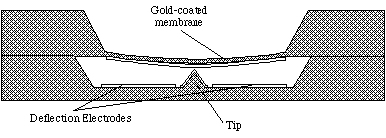

The sensor is constructed with roughly 1 micron of separation between the membrane and tip. To pull the membrane close enough to enable tunneling currents, an electrostatic force is created by applying a large voltage(100s of Volts) between the membrane and the deflection electrodes. An external circuit controls this "deflection voltage" to maintain a constant tunneling current. For our sensor, a tunneling current of approximately 1 nA occurs when the separation distance is about 10 Angstroms and we apply 175 mV between the membrane and tip.
Since this system balances the forces on the membrane to keep the current (and therefore separation distance) constant, we can measure the external forces on the membrane by measuring the force the controller applies to balance these external forces. So to measure different phenomena, we need to make these phenomena apply forces on the membrane. We've successfully built an IR sensor, and we are looking into accelerometers and magnetometers.
Download a more detailed paper about the physics of the sensor (Word 5.1, 250k)
Download a more detailed paper about the physics of the sensor (RTF)